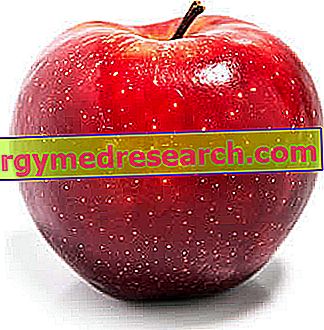Generality
That the apple is the apple fruit (botanical name Malus communis ) is a fact that is far from being a novelty, just as the old saying that " an apple a day keeps the doctor away " does not tell us anything new. .

Property and Effectiveness
Nutritional characteristics of the apple
The apple is a product that belongs to the VII fundamental group of foods.
It has a moderate energy content: a common apple weighs 242 grams and provides 126 kcal. In the diet it can be used as a snack, as a breakfast food or as a closure for a main meal.
Energy is supplied mainly by carbohydrates, followed marginally by proteins and lipids. Carbohydrates are mainly simple, consisting of fructose, and peptides are of low biological value.
Apples contain discrete concentrations of fiber which, as we shall see in the next section, are largely soluble. Cholesterol is absent.
As far as vitamins are concerned, the concentration of ascorbic acid (vitamin C) stands out; with regard to mineral salts, potassium levels are appreciable.
Apples are fruits that do not contain gluten and lactose, and are edible even from raw. These characteristics make them relevant to diets: vegetarian, vegan, raw food, for celiac disease and for lactose intolerance.
In reasonable portions they do not have contraindications; like most foods that contain carbohydrates, their average portion and frequency of consumption must be adapted to overweight, type 2 diabetes mellitus and hypertriglyceridemia.
The average portion of apple is 1-2 fruit from 200-250 g (75-260 kcal).
| Apple, with peel | |||
| Nutritional values per 100 g | |||
 | |||
| Power | 52 kcal | * RDA | |
| Total carbohydrates | 13.81 g | ||
| Starch | - g | ||
| Simple sugars | 10.39 g | ||
| fibers | 2.4 g | ||
| Grassi | 0.17 g | ||
| Saturated | - g | ||
| Monounsaturated | - g | ||
| polyunsaturated | - g | ||
| Protein | 0.26 g | ||
| water | 85.56 g | ||
| Vitamins | |||
| Vitamin A equivalent | 3.0 μg | 0% | |
| Beta-carotene | 27.0 μg | 0% | |
| Lutein Zexanthin | 29.0 μg | ||
| Thiamine or B1 | 0.017 mg | 1% | |
| Riboflavin or B2 | 0.026 mg | 2% | |
| Niacin or PP or B3 | 0.091 mg | 1% | |
| Pantothenic acid or B5 | 0.061 mg | 1% | |
| Pyridoxine or B6 | 0.041 mg | 3% | |
| Folic acid | 3.0 μg | 1% | |
| Choline | - mg | -% | |
| Ascorbic acid or C | 4.6 mg | 6% | |
| Vitamin D | - μg | -% | |
| Alpha-tocopherol or E | 0.18 mg | 1% | |
| Vit. K | 2.2 μg | 2% | |
| Minerals | |||
| Football | 6.0 mg | 1% | |
| Iron | 0.12 mg | 1% | |
| Magnesium | 5.0 mg | 1% | |
| Manganese | 0.035 mg | 2% | |
| Phosphorus | 11.0 mg | 2% | |
| Potassium | 107.0 mg | 2% | |
| Sodium | 1.0 mg | 0% | |
| Zinc | 0.04 mg | 0% | |
| Fluoride | 3.3, μg | ||
* Notes :
Percentages are approximately calculated using US recommendations for adults.
Unit:
- μg = micrograms
- mg = milligrams
- IU = international units
Healthy properties of the apple
The apple is a food that contributes to maintaining good health. It acts positively, for example, on cholesterol, but is also a valid ally to combat the hated extra pounds . All this, of course, provided that the apples are included in a dietary plan I do not say rigorous, but nevertheless careful and respectful of the health of the gourmet.
Let's start by saying that like vegetables and some types of fruit, apple is an ideal food to start a meal.
If while we are engaged in the preparation of laborious culinary courses we are caught by an irresistible appetite, munching an apple is the best solution. Consuming one of these fruits before the three main meals helps to calm even the most voracious appetite, even better if you associate it with a nice glass of water.
Apple pectin
The secret of the extraordinary nutritional and health properties of apples is largely hidden behind a soluble fiber, called pectin, of which they are particularly rich.
This indigestible polysaccharide helps control cholesterol levels, helps regulate bowel function and controls appetite. Furthermore, its fermentation by intestinal bacterial flora, gives rise to short chain fatty acids, which appear to have a protective effect on the development of colon cancer.
An apple of medium size, when consumed together with the peel, provides about 4 grams of fiber. However, unlike the one present in many other foods (such as whole grains, their bran and certain vegetables) a good part of the fiber contained in the apple is soluble in water (being made up of pectin, to be precise). This property allows it to form, inside our intestines, a gelatinous mass, which traps excess lipids and sugars inside it, but also some dangerous substances and, it must be said, important micronutrients for our body.
However, since fortunately we have excess food available, this last aspect must simply remind us that we must never exaggerate the consumption of a given food, even when it is particularly beneficial as the apple. In short, just to stay on the subject of popular sayings ... too lame.
Positive effects of apple and pectin consumption
The apple, along with citrus fruits, is one of the most generous sources of pectin, from which it is extracted and purified in order to add it to many food supplements and dietary products, including those for diabetics (pectin supplements lower postprandial blood sugar) and for weight control.
However, in many cases, scholars have shown that, for the same weight, the natural source as a whole (the apple in this case) is much healthier than the single substance isolated from it (pectin taken as supplement). In fact, apples do not only contain fiber, but also precious vitamins and minerals.
Apple for diuresis and against constipation
The apple has a good diuretic power and is indicated in disorders of the gastrointestinal tract (diarrhea, constipation and meteorism); in fact, pectin does not have a real laxative function, but rather a "modulating" effect, which normalizes intestinal peristalsis.
Other advantages
Other Benefits of apple consumption
The apple is a practical food, ready for consumption and does not dirty clothes when it falls on us, aspects that are certainly not negligible in the fast-paced era of fast food.
Moreover, its tasty and crunchy taste, slightly sweet, brings together the vast majority of palates, including those more reticent to the consumption of fruit and vegetables.
An important and essential requirement of apples is their freshness. Over time, in fact, the water and vitamin content of the fruit gradually decays, making it less crisp and healthy.
A good criterion for evaluating the freshness of an apple is to observe its peel . When it is shiny and tight, to protect a compact pulp, it means that the fruit has been picked recently and / or preserved in the best way; on the contrary, a wrinkled skin, like the wrinkles on a person's face, indicates that the times of youth are now a distant memory.
Once purchased, the apples should be kept in the refrigerator, where the temperature, just above 0 ° C (but which does not determine crystallization in ice), allows it to maintain its characteristic crunchiness and flavor for a long time.
Apples: eat them with or without peel?
Personally I eat apples with their peel; obviously, only after a thorough and generous washing. That this is a source of dangerous pesticides, in fact, is only partially true:
- Some protection, first of all, derives from the controls to which the apples are subjected even before the harvest, so that, in theory, at the time of consumption the fruit should by now have lost all dangerous residues.
- Secondly, the pesticides used in agriculture in industrialized countries like ours are not those deadly poisons that one is led to believe, especially when they are ingested in insignificant quantities.
- Third, the non-systemic products, those that remain on the surface of the fruits, as well as the pollutants, are concentrated above all in the invasion placed at the two vertices. It is therefore important to remove these two parts of the fruit rather than peel it completely.
- Fourth, many plant foods, even if caught in the most pristine place that exists, contain far more dangerous poisons within them than those used to protect them from various pests and critters. The apple seeds themselves, for example, contain cyanide, although in completely harmless quantities. The apple tree and the other plants, in fact, do not have legs or wings, consequently they cannot escape from the "predators"; on the other hand, they can defend themselves by developing toxic substances for the animals that eat them.
Therefore, since "everything is poison, nothing is poison, the difference lies in the dose" many experts agree that apples can be safely consumed by preserving the peel after an appropriate wash; as a precautionary measure, it is better to remove it if the fruit is consumed during pregnancy or weaning.
Recipes with Apples
Apple Pie - American Apple Pie without Butter
The video shows the preparation of the famous Apple Pie, American Apple Pie, with less fat and calories than the original recipe.
Apple Pie
X Problems with video playback? Reload from YouTube Go to Video Page Go to Video Recipes Section Watch the video on youtubeSee All Recipes with Apples »



